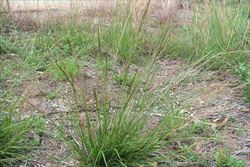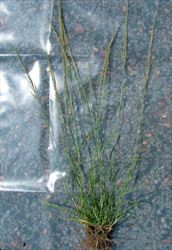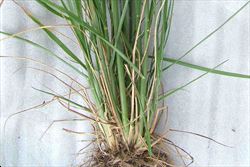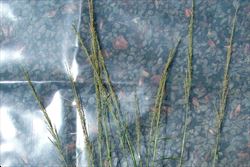Click on images to enlarge

habit (Photo: John Thompson)

habit (Photo: John Thompson)

stems and leaves (Photo: John Thompson)

roots and lower leaves (Photo: John Thompson)

close-up of leaves (Photo: John Thompson)

seed-heads (Photo: John Thompson)

seed-heads of various ages (Photo: John Thompson)

close-up of mature flower spikelets and seeds (Photo: Sangita Shrestha)
Scientific Name
Sporobolus jacquemontii Kunth
Synonyms
Sporobolus pyramidalis P. Beauv. var. jacquemontii (Kunth) Jovet & GuédèsVilfa jacquemontii (Kunth) Trin.
Family
Gramineae (South Australia)Poaceae (Queensland, New South Wales, the ACT, Victoria, Tasmania, Western Australia and the Northern Territory)
Common Names
American rat's tail grass, American ratstail grass, giant smutgrass, large smutgrass, smutgrass, West Indian dropseed, West Indian rush-grass, West Indies smutgrass
Origin
Native to Mexico, Central America, the Caribbean and tropical South America (i.e. French Guiana, Guyana, Surinam, Venezuela, Brazil, Bolivia, Colombia, Ecuador and Peru).
Naturalised Distribution
This species is widely distributed in the north-eastern parts of Australia, and is most commonly found in the coastal regions of northern and central Queensland. It is also scattered in south-eastern Queensland and present in the northern parts of Western Australia.
Habitat
A weed of pastures, roadsides, creek banks, disturbed sites, open woodlands and grasslands in tropical and sub-tropical regions.
Habit
An upright (i.e. erect), densely tufted, and long-lived (i.e. perennial) grass usually growing 50-75 cm tall.
Distinguishing Features
- an upright and tufted long-lived grass usually growing 50-75 cm tall.
- its long and narrow leaf blades (up to 40 cm long and 2.5-3.5 mm wide) may be flat or somewhat rolled.
- its seed-heads are relatively thin and elongated in appearance (8-25 cm long and 5-30 mm wide).
- they are spike-like with numerous slightly spreading, relatively long, branches (5-10 cm long).
- each of these branches bears numerous tiny flower spikelets (1.5-2 mm long).
Stems and Leaves
The flowering stems (i.e culms) are relatively slender (1-5 mm thick), but somewhat wiry, and may be branched.
The leaves are very thin (i.e. linear or filiform) with a leaf sheath, which partially encloses the stem, and a spreading leaf blade. The leaf sheaths are hairless (i.e. glabrous) and the leaf blades (up to 40 cm long and 2.5-3.5 mm wide) may be flat or somewhat rolled (i.e. convolute). These leaf blades are also hairless (i.e. glabrous) and have pointed tips (i.e. acuminate apices). Where the leaf sheath meets the leaf blade there is a fringe of tiny hairs (i.e. ciliated ligule) or a tiny membrane topped with hairs (i.e. ciliated membrane) 0.2-0.3 mm long.
Flowers and Fruit
The seed-heads are borne at the top of the stems and are thin and elongated (i.e. lanceolate) in appearance (8-25 cm long and 5-30 mm wide). They are slightly open panicles, with relatively long branches (5-10 cm long) that diverge slightly away from the central stalk of the seed-head (i.e. rachis). Each of these branches bears numerous, tiny, elongated (i.e. lanceolate) or oval (i.e. elliptic) flower spikelets almost to their bases. The dark green or greyish-green flower spikelets (1.5-2 mm long) contain a single tiny flower (i.e. floret) inside two bracts (i.e. glumes). The lower bract (i.e. glume) is 0.3-0.4 mm long and the upper bract (i.e. glume) is 0.5-0.8 mm long (i.e. less than half the length of the flower spikelet). Flowering occurs throughout the year.
The tiny seeds (i.e. grains or caryopses) turn reddish-brown in colour as they mature and are oblong or egg-shaped (i.e. obovoid). These seeds (0.8-1 mm long and up to 0.5 mm wide) separate from the remainder of the flower spikelet at maturity (i.e. the pale coloured old glumes remain on the seed-head).
Reproduction and Dispersal
This species produces large quantities of tiny seeds that are somewhat sticky when wet. These seeds may be spread after becoming attached to animals, clothing and vehicles. They may also be dispersed by water, in mud, and in contaminated agricultural produce (e.g. in fodder and pasture seed lots).
Environmental Impact
American rat's tail grass (Sporobolus jacquemontii ) is regarded as an environmental weed in Queensland.
Legislation
This species is declared under legislation in the following states and territories:
- Queensland: Class 2 - landowners must take all reasonable steps to keep land free of this species (throughout the entire state). It is also illegal to sell a declared plant or its seed in this state.
- Western Australia: Unassessed - this species is declared in other states or territories and is prohibited until assessed via a weed risk assessment (throughout the entire state).
Management
For information on the management of this species see the following resources:
- the Biosecurity Queensland Fact Sheet on giant rats tail grass and other weedy Sporobolus species, which is available online at http://www.dpi.qld.gov.au.
Similar Species
American rats-tail grass (Sporobolus jacquemontii ) is very similar to other introduced rats-tail grasses (Sporobolus spp.), including giant Parramatta grass (Sporobolus fertilis), Parramatta grass (Sporobolus africanus ), and the giant rats-tail grasses (Sporobolus pyramidalis and Sporobolus natalensis ). It is also similar to some native species such as the slender rats-tail grasses (Sporobolus creber and Sporobolus elongatus). Distinguishing between these species is often very difficult and a specialist may need to be consulted, however the following is a guide to the differences that may be apparent:
- American rats-tail grass (Sporobolus jacquemontii) is a moderately-sized plant (usually 50-75 cm tall) with relatively small elongated seed-heads (8-25 cm long). These seed-heads have numerous relatively long branches (50-100 mm long) that usually spread away from the main stem. These branches are normally densely arranged and the seed-head is un-interrupted. Its flower spikelets are relatively small (1.5-2 mm long).
- giant Parramatta grass (Sporobolus fertilis) is a relatively large plant (usually 80-160 cm tall) with relatively large spike-like (i.e. spiciform) seed-heads (15-50 cm long). These seed-heads have numerous moderately long branches (20-80 mm long) that are held closely (i.e. appressed) to the main stem or slightly spreading. These branches are normally densely arranged and the seed-head is mostly un-interrupted (except occasionally at the base). Its flower spikelets are relatively small (1.5-2 mm long).
- Parramatta grass (Sporobolus africanus) is a relatively small plant (usually less than 50 cm tall) with relatively small spike-like (i.e. spiciform) seed-heads (6-35 cm long). These seed-heads have numerous short branches (10-20 mm long) that are usually held closely (i.e. appressed) to the main stem. These branches are normally densely arranged and the seed-head is mostly un-interrupted (except occasionally at the base). Its flower spikelets are relatively large (2-2.8 mm long).
- giant rats-tail grass (Sporobolus pyramidalis) is a relatively large plant (usually 90-200 cm tall) with relatively large pyramid-shaped (i.e. pyramidal) seed-heads (20-45 cm long). These seed-heads have numerous relatively long branches (50-100 mm long) that stiffly spread away from the main stem. Its flower spikelets are moderately-sized (1.7-2.2 mm long).
- giant rats-tail grass (Sporobolus natalensis) is a relatively large plant (60-150 cm tall) with relatively large spike-like (i.e. spiciform) seed-heads (20-30 cm long). These seed-heads have numerous relatively long branches (30-70 mm long) that usually spread away from the main stem. These branches are normally densely arranged and the seed-head is un-interrupted. Its flower spikelets are moderately-sized (1.6-2.3 mm long).
- slender rats-tail grass (Sporobolus creber) is a moderately-sized plant (usually less than 100 cm tall) with relatively long and very narrow spike-like (i.e. spiciform) seed-heads (18-60 cm long). These seed-heads have numerous short stiff branches (5-10 mm long) that are always held closely (i.e. appressed) to the main stem. These branches are normally widely spaced and the seed-head is interrupted (except near the top). Its flower spikelets are relatively small (1.2-1.7 mm long).
- slender rats-tail grass (Sporobolus elongatus) is a moderately-sized plant (usually 50-100 cm tall) with relatively long and narrow spike-like (i.e. spiciform) seed-heads (10-30 cm long). These seed-heads have numerous relatively long branches (40-80 mm long) that are usually held closely (i.e. appressed) to the main stem (sometimes slightly spreading). These branches are normally densely arranged and the seed-head is mostly un-interrupted (except occasionally at the base). Its flower spikelets are moderately-sized (1.5-2.3 mm long).

